Risks in Foreign Direct Investment: A Case Study of Rio Tinto in Mongolia
VerifiedAdded on 2022/11/23
|10
|2239
|180
AI Summary
This report investigates the different risks present during a foreign direct investment, specifically in the case of Rio Tinto's copper mining project in Mongolia. The risks include political, economic, and financial factors, and the report discusses mitigation strategies through capital budgeting decisions.
Contribute Materials
Your contribution can guide someone’s learning journey. Share your
documents today.
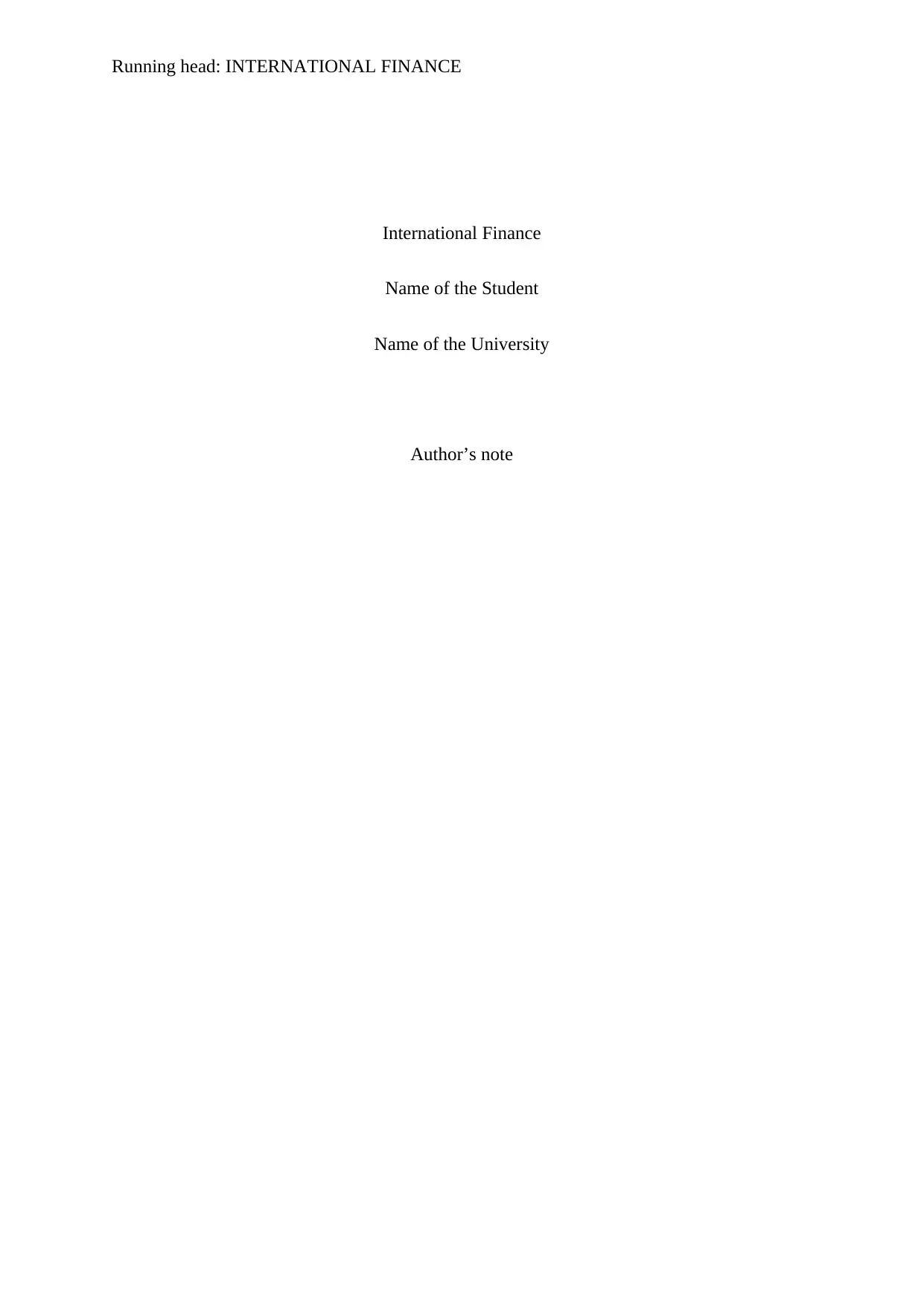
Running head: INTERNATIONAL FINANCE
International Finance
Name of the Student
Name of the University
Author’s note
International Finance
Name of the Student
Name of the University
Author’s note
Secure Best Marks with AI Grader
Need help grading? Try our AI Grader for instant feedback on your assignments.
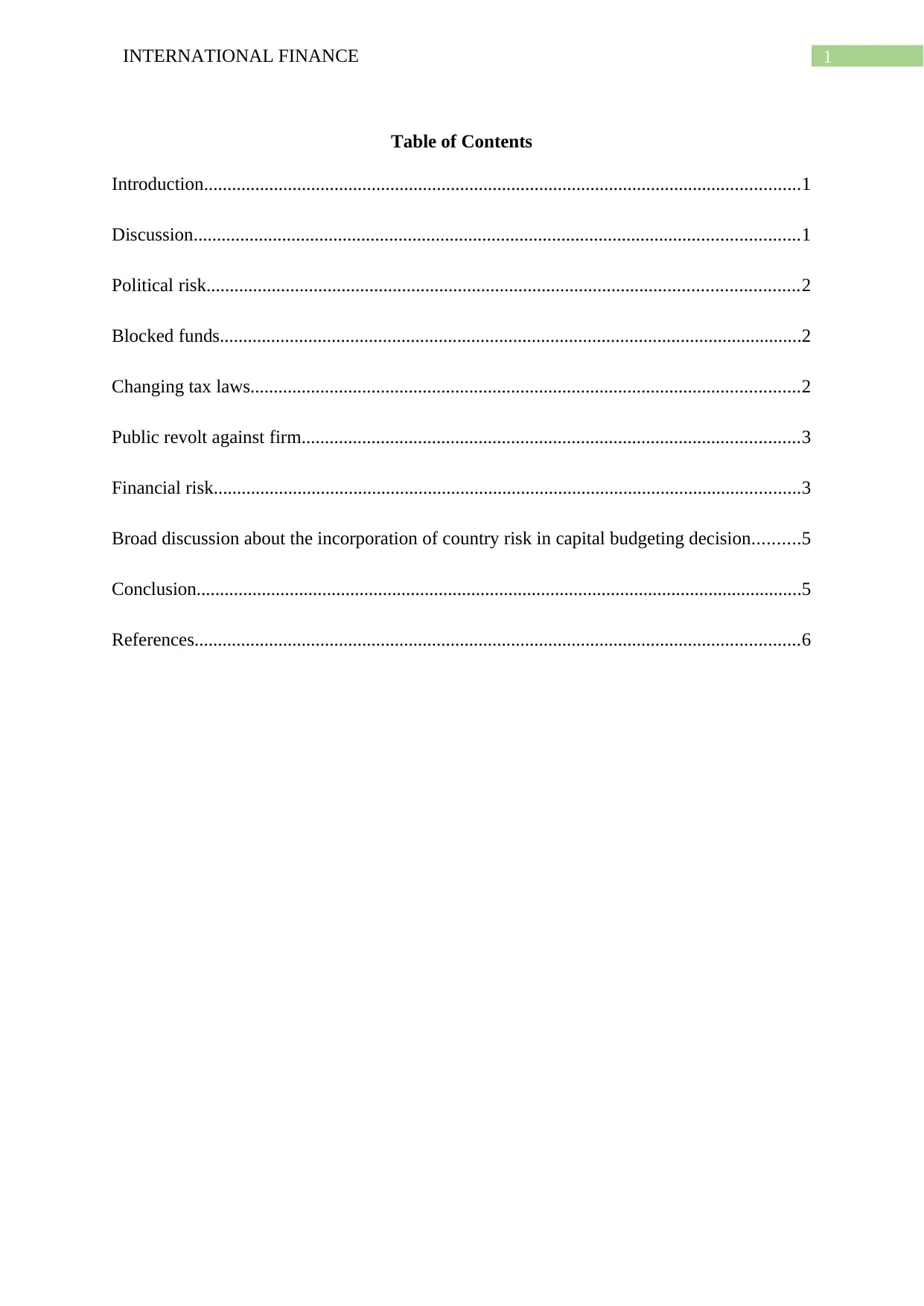
1INTERNATIONAL FINANCE
Table of Contents
Introduction................................................................................................................................1
Discussion..................................................................................................................................1
Political risk...............................................................................................................................2
Blocked funds.............................................................................................................................2
Changing tax laws......................................................................................................................2
Public revolt against firm...........................................................................................................3
Financial risk..............................................................................................................................3
Broad discussion about the incorporation of country risk in capital budgeting decision..........5
Conclusion..................................................................................................................................5
References..................................................................................................................................6
Table of Contents
Introduction................................................................................................................................1
Discussion..................................................................................................................................1
Political risk...............................................................................................................................2
Blocked funds.............................................................................................................................2
Changing tax laws......................................................................................................................2
Public revolt against firm...........................................................................................................3
Financial risk..............................................................................................................................3
Broad discussion about the incorporation of country risk in capital budgeting decision..........5
Conclusion..................................................................................................................................5
References..................................................................................................................................6
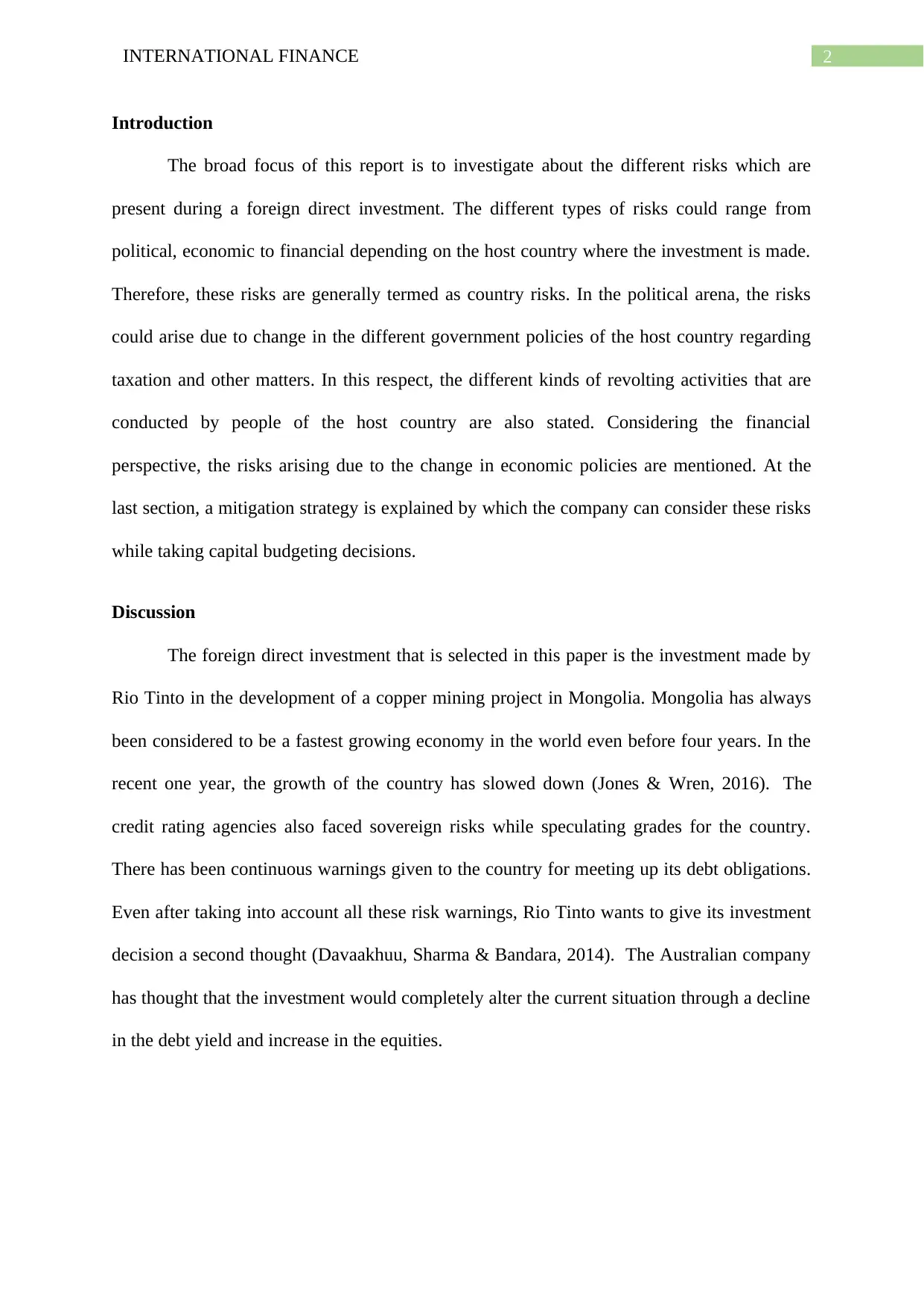
2INTERNATIONAL FINANCE
Introduction
The broad focus of this report is to investigate about the different risks which are
present during a foreign direct investment. The different types of risks could range from
political, economic to financial depending on the host country where the investment is made.
Therefore, these risks are generally termed as country risks. In the political arena, the risks
could arise due to change in the different government policies of the host country regarding
taxation and other matters. In this respect, the different kinds of revolting activities that are
conducted by people of the host country are also stated. Considering the financial
perspective, the risks arising due to the change in economic policies are mentioned. At the
last section, a mitigation strategy is explained by which the company can consider these risks
while taking capital budgeting decisions.
Discussion
The foreign direct investment that is selected in this paper is the investment made by
Rio Tinto in the development of a copper mining project in Mongolia. Mongolia has always
been considered to be a fastest growing economy in the world even before four years. In the
recent one year, the growth of the country has slowed down (Jones & Wren, 2016). The
credit rating agencies also faced sovereign risks while speculating grades for the country.
There has been continuous warnings given to the country for meeting up its debt obligations.
Even after taking into account all these risk warnings, Rio Tinto wants to give its investment
decision a second thought (Davaakhuu, Sharma & Bandara, 2014). The Australian company
has thought that the investment would completely alter the current situation through a decline
in the debt yield and increase in the equities.
Introduction
The broad focus of this report is to investigate about the different risks which are
present during a foreign direct investment. The different types of risks could range from
political, economic to financial depending on the host country where the investment is made.
Therefore, these risks are generally termed as country risks. In the political arena, the risks
could arise due to change in the different government policies of the host country regarding
taxation and other matters. In this respect, the different kinds of revolting activities that are
conducted by people of the host country are also stated. Considering the financial
perspective, the risks arising due to the change in economic policies are mentioned. At the
last section, a mitigation strategy is explained by which the company can consider these risks
while taking capital budgeting decisions.
Discussion
The foreign direct investment that is selected in this paper is the investment made by
Rio Tinto in the development of a copper mining project in Mongolia. Mongolia has always
been considered to be a fastest growing economy in the world even before four years. In the
recent one year, the growth of the country has slowed down (Jones & Wren, 2016). The
credit rating agencies also faced sovereign risks while speculating grades for the country.
There has been continuous warnings given to the country for meeting up its debt obligations.
Even after taking into account all these risk warnings, Rio Tinto wants to give its investment
decision a second thought (Davaakhuu, Sharma & Bandara, 2014). The Australian company
has thought that the investment would completely alter the current situation through a decline
in the debt yield and increase in the equities.
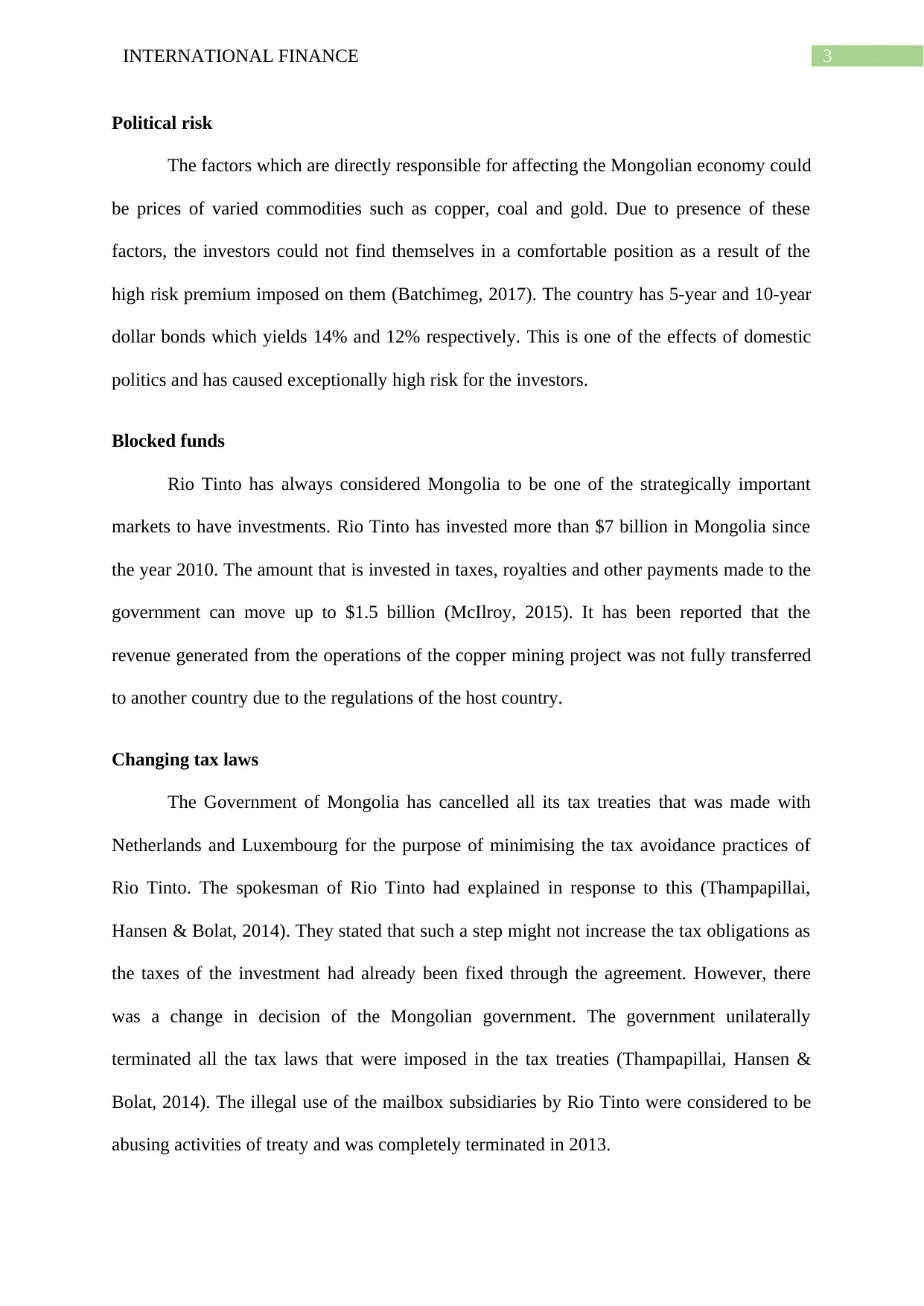
3INTERNATIONAL FINANCE
Political risk
The factors which are directly responsible for affecting the Mongolian economy could
be prices of varied commodities such as copper, coal and gold. Due to presence of these
factors, the investors could not find themselves in a comfortable position as a result of the
high risk premium imposed on them (Batchimeg, 2017). The country has 5-year and 10-year
dollar bonds which yields 14% and 12% respectively. This is one of the effects of domestic
politics and has caused exceptionally high risk for the investors.
Blocked funds
Rio Tinto has always considered Mongolia to be one of the strategically important
markets to have investments. Rio Tinto has invested more than $7 billion in Mongolia since
the year 2010. The amount that is invested in taxes, royalties and other payments made to the
government can move up to $1.5 billion (McIlroy, 2015). It has been reported that the
revenue generated from the operations of the copper mining project was not fully transferred
to another country due to the regulations of the host country.
Changing tax laws
The Government of Mongolia has cancelled all its tax treaties that was made with
Netherlands and Luxembourg for the purpose of minimising the tax avoidance practices of
Rio Tinto. The spokesman of Rio Tinto had explained in response to this (Thampapillai,
Hansen & Bolat, 2014). They stated that such a step might not increase the tax obligations as
the taxes of the investment had already been fixed through the agreement. However, there
was a change in decision of the Mongolian government. The government unilaterally
terminated all the tax laws that were imposed in the tax treaties (Thampapillai, Hansen &
Bolat, 2014). The illegal use of the mailbox subsidiaries by Rio Tinto were considered to be
abusing activities of treaty and was completely terminated in 2013.
Political risk
The factors which are directly responsible for affecting the Mongolian economy could
be prices of varied commodities such as copper, coal and gold. Due to presence of these
factors, the investors could not find themselves in a comfortable position as a result of the
high risk premium imposed on them (Batchimeg, 2017). The country has 5-year and 10-year
dollar bonds which yields 14% and 12% respectively. This is one of the effects of domestic
politics and has caused exceptionally high risk for the investors.
Blocked funds
Rio Tinto has always considered Mongolia to be one of the strategically important
markets to have investments. Rio Tinto has invested more than $7 billion in Mongolia since
the year 2010. The amount that is invested in taxes, royalties and other payments made to the
government can move up to $1.5 billion (McIlroy, 2015). It has been reported that the
revenue generated from the operations of the copper mining project was not fully transferred
to another country due to the regulations of the host country.
Changing tax laws
The Government of Mongolia has cancelled all its tax treaties that was made with
Netherlands and Luxembourg for the purpose of minimising the tax avoidance practices of
Rio Tinto. The spokesman of Rio Tinto had explained in response to this (Thampapillai,
Hansen & Bolat, 2014). They stated that such a step might not increase the tax obligations as
the taxes of the investment had already been fixed through the agreement. However, there
was a change in decision of the Mongolian government. The government unilaterally
terminated all the tax laws that were imposed in the tax treaties (Thampapillai, Hansen &
Bolat, 2014). The illegal use of the mailbox subsidiaries by Rio Tinto were considered to be
abusing activities of treaty and was completely terminated in 2013.
Secure Best Marks with AI Grader
Need help grading? Try our AI Grader for instant feedback on your assignments.
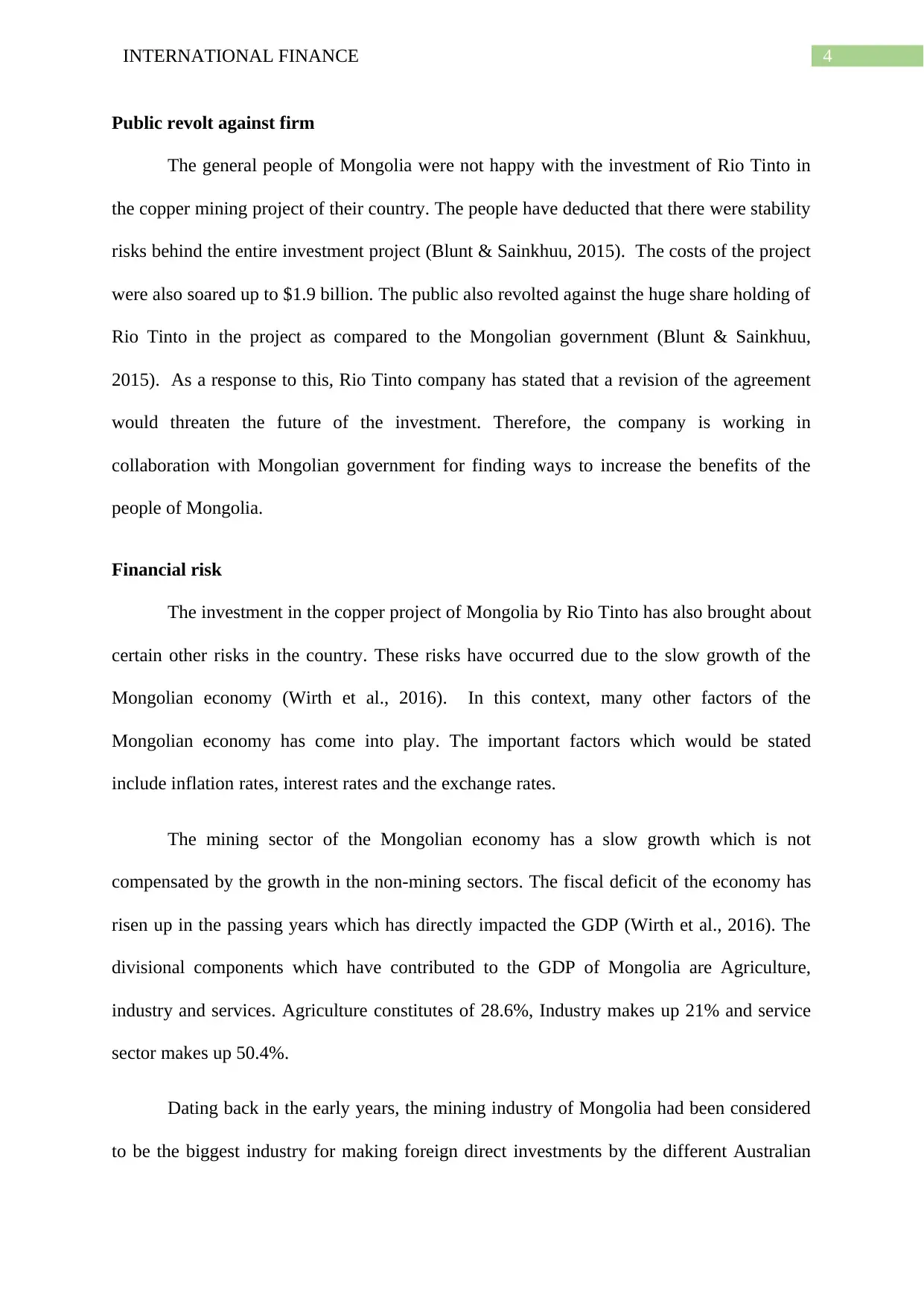
4INTERNATIONAL FINANCE
Public revolt against firm
The general people of Mongolia were not happy with the investment of Rio Tinto in
the copper mining project of their country. The people have deducted that there were stability
risks behind the entire investment project (Blunt & Sainkhuu, 2015). The costs of the project
were also soared up to $1.9 billion. The public also revolted against the huge share holding of
Rio Tinto in the project as compared to the Mongolian government (Blunt & Sainkhuu,
2015). As a response to this, Rio Tinto company has stated that a revision of the agreement
would threaten the future of the investment. Therefore, the company is working in
collaboration with Mongolian government for finding ways to increase the benefits of the
people of Mongolia.
Financial risk
The investment in the copper project of Mongolia by Rio Tinto has also brought about
certain other risks in the country. These risks have occurred due to the slow growth of the
Mongolian economy (Wirth et al., 2016). In this context, many other factors of the
Mongolian economy has come into play. The important factors which would be stated
include inflation rates, interest rates and the exchange rates.
The mining sector of the Mongolian economy has a slow growth which is not
compensated by the growth in the non-mining sectors. The fiscal deficit of the economy has
risen up in the passing years which has directly impacted the GDP (Wirth et al., 2016). The
divisional components which have contributed to the GDP of Mongolia are Agriculture,
industry and services. Agriculture constitutes of 28.6%, Industry makes up 21% and service
sector makes up 50.4%.
Dating back in the early years, the mining industry of Mongolia had been considered
to be the biggest industry for making foreign direct investments by the different Australian
Public revolt against firm
The general people of Mongolia were not happy with the investment of Rio Tinto in
the copper mining project of their country. The people have deducted that there were stability
risks behind the entire investment project (Blunt & Sainkhuu, 2015). The costs of the project
were also soared up to $1.9 billion. The public also revolted against the huge share holding of
Rio Tinto in the project as compared to the Mongolian government (Blunt & Sainkhuu,
2015). As a response to this, Rio Tinto company has stated that a revision of the agreement
would threaten the future of the investment. Therefore, the company is working in
collaboration with Mongolian government for finding ways to increase the benefits of the
people of Mongolia.
Financial risk
The investment in the copper project of Mongolia by Rio Tinto has also brought about
certain other risks in the country. These risks have occurred due to the slow growth of the
Mongolian economy (Wirth et al., 2016). In this context, many other factors of the
Mongolian economy has come into play. The important factors which would be stated
include inflation rates, interest rates and the exchange rates.
The mining sector of the Mongolian economy has a slow growth which is not
compensated by the growth in the non-mining sectors. The fiscal deficit of the economy has
risen up in the passing years which has directly impacted the GDP (Wirth et al., 2016). The
divisional components which have contributed to the GDP of Mongolia are Agriculture,
industry and services. Agriculture constitutes of 28.6%, Industry makes up 21% and service
sector makes up 50.4%.
Dating back in the early years, the mining industry of Mongolia had been considered
to be the biggest industry for making foreign direct investments by the different Australian
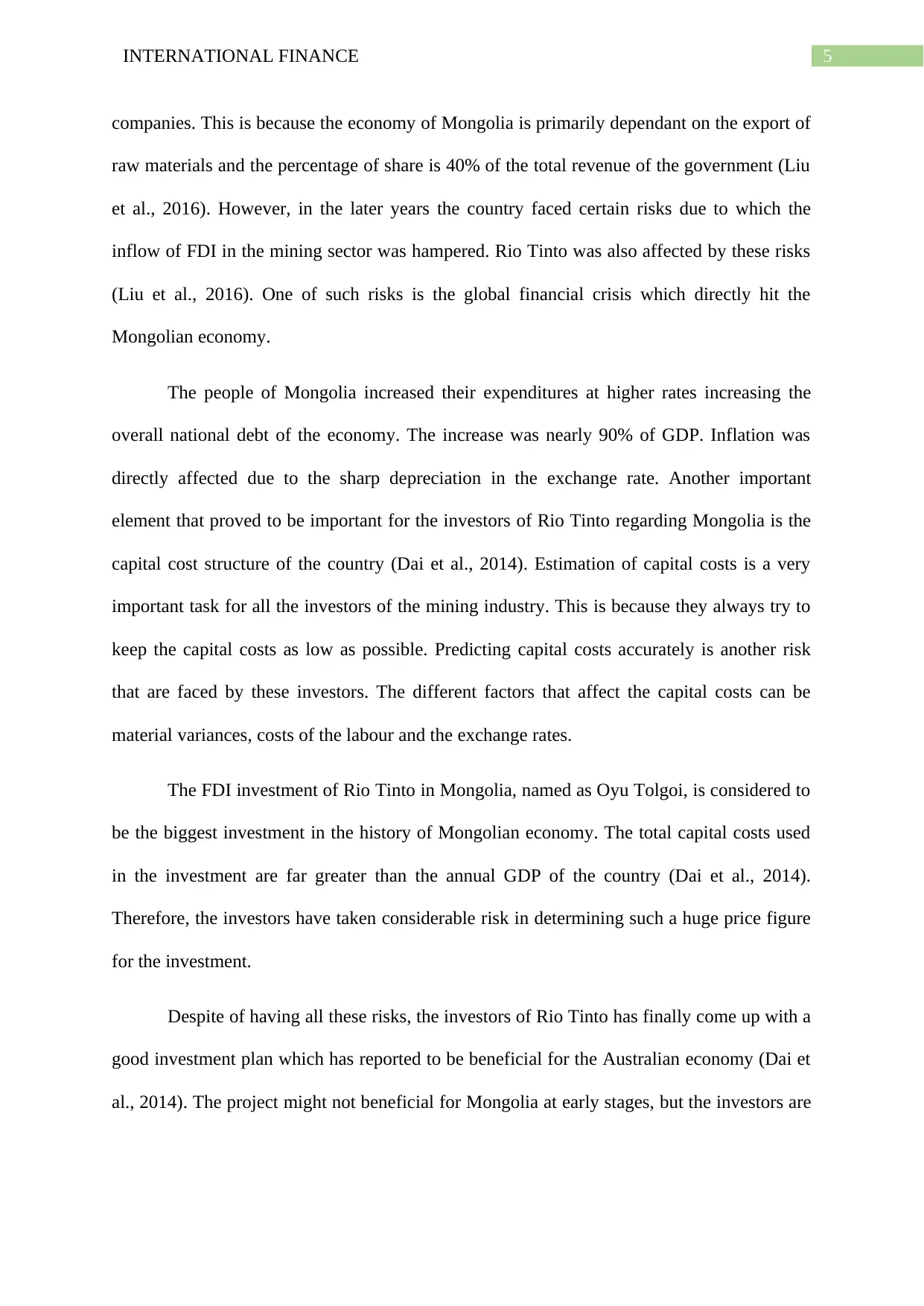
5INTERNATIONAL FINANCE
companies. This is because the economy of Mongolia is primarily dependant on the export of
raw materials and the percentage of share is 40% of the total revenue of the government (Liu
et al., 2016). However, in the later years the country faced certain risks due to which the
inflow of FDI in the mining sector was hampered. Rio Tinto was also affected by these risks
(Liu et al., 2016). One of such risks is the global financial crisis which directly hit the
Mongolian economy.
The people of Mongolia increased their expenditures at higher rates increasing the
overall national debt of the economy. The increase was nearly 90% of GDP. Inflation was
directly affected due to the sharp depreciation in the exchange rate. Another important
element that proved to be important for the investors of Rio Tinto regarding Mongolia is the
capital cost structure of the country (Dai et al., 2014). Estimation of capital costs is a very
important task for all the investors of the mining industry. This is because they always try to
keep the capital costs as low as possible. Predicting capital costs accurately is another risk
that are faced by these investors. The different factors that affect the capital costs can be
material variances, costs of the labour and the exchange rates.
The FDI investment of Rio Tinto in Mongolia, named as Oyu Tolgoi, is considered to
be the biggest investment in the history of Mongolian economy. The total capital costs used
in the investment are far greater than the annual GDP of the country (Dai et al., 2014).
Therefore, the investors have taken considerable risk in determining such a huge price figure
for the investment.
Despite of having all these risks, the investors of Rio Tinto has finally come up with a
good investment plan which has reported to be beneficial for the Australian economy (Dai et
al., 2014). The project might not beneficial for Mongolia at early stages, but the investors are
companies. This is because the economy of Mongolia is primarily dependant on the export of
raw materials and the percentage of share is 40% of the total revenue of the government (Liu
et al., 2016). However, in the later years the country faced certain risks due to which the
inflow of FDI in the mining sector was hampered. Rio Tinto was also affected by these risks
(Liu et al., 2016). One of such risks is the global financial crisis which directly hit the
Mongolian economy.
The people of Mongolia increased their expenditures at higher rates increasing the
overall national debt of the economy. The increase was nearly 90% of GDP. Inflation was
directly affected due to the sharp depreciation in the exchange rate. Another important
element that proved to be important for the investors of Rio Tinto regarding Mongolia is the
capital cost structure of the country (Dai et al., 2014). Estimation of capital costs is a very
important task for all the investors of the mining industry. This is because they always try to
keep the capital costs as low as possible. Predicting capital costs accurately is another risk
that are faced by these investors. The different factors that affect the capital costs can be
material variances, costs of the labour and the exchange rates.
The FDI investment of Rio Tinto in Mongolia, named as Oyu Tolgoi, is considered to
be the biggest investment in the history of Mongolian economy. The total capital costs used
in the investment are far greater than the annual GDP of the country (Dai et al., 2014).
Therefore, the investors have taken considerable risk in determining such a huge price figure
for the investment.
Despite of having all these risks, the investors of Rio Tinto has finally come up with a
good investment plan which has reported to be beneficial for the Australian economy (Dai et
al., 2014). The project might not beneficial for Mongolia at early stages, but the investors are
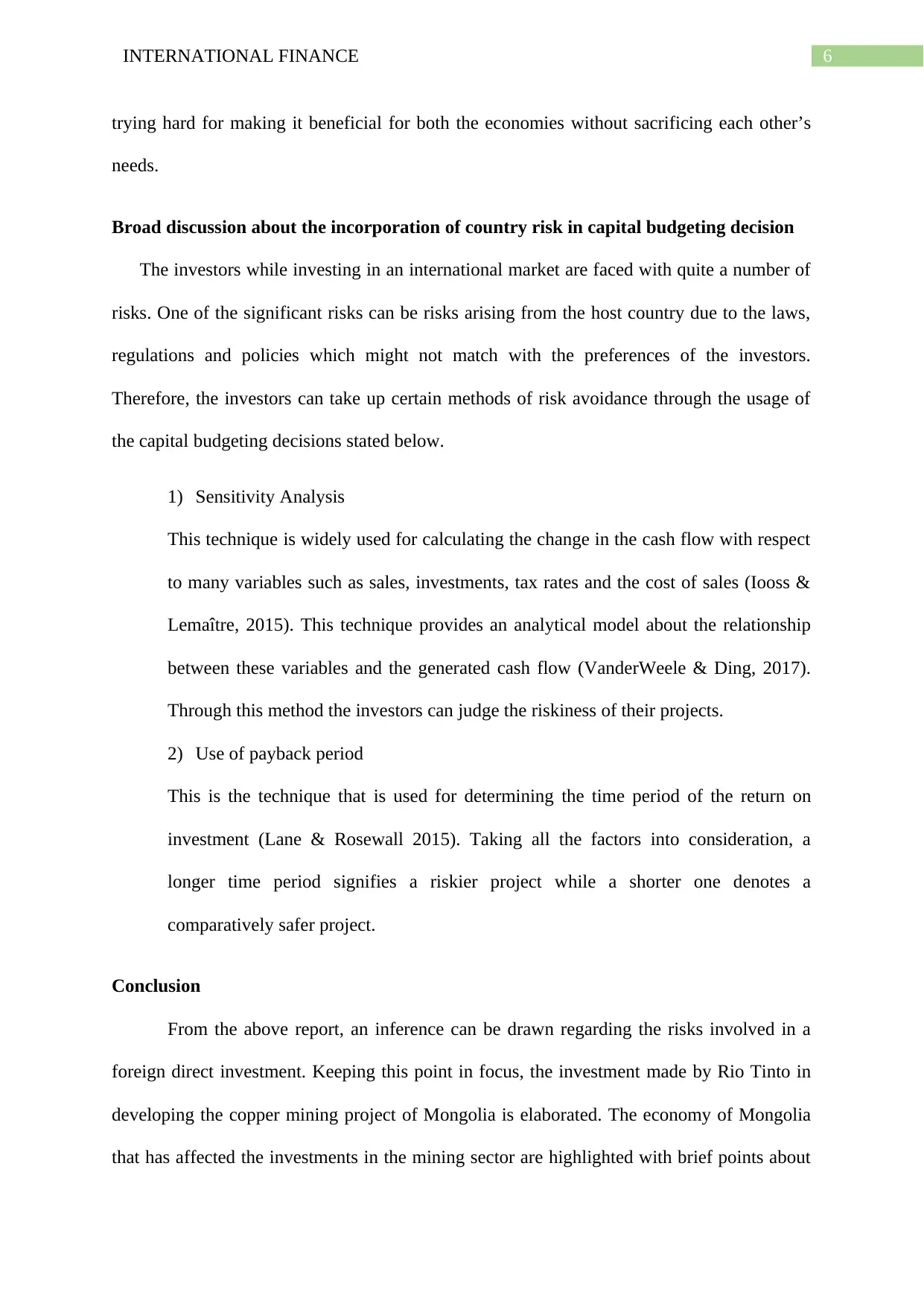
6INTERNATIONAL FINANCE
trying hard for making it beneficial for both the economies without sacrificing each other’s
needs.
Broad discussion about the incorporation of country risk in capital budgeting decision
The investors while investing in an international market are faced with quite a number of
risks. One of the significant risks can be risks arising from the host country due to the laws,
regulations and policies which might not match with the preferences of the investors.
Therefore, the investors can take up certain methods of risk avoidance through the usage of
the capital budgeting decisions stated below.
1) Sensitivity Analysis
This technique is widely used for calculating the change in the cash flow with respect
to many variables such as sales, investments, tax rates and the cost of sales (Iooss &
Lemaître, 2015). This technique provides an analytical model about the relationship
between these variables and the generated cash flow (VanderWeele & Ding, 2017).
Through this method the investors can judge the riskiness of their projects.
2) Use of payback period
This is the technique that is used for determining the time period of the return on
investment (Lane & Rosewall 2015). Taking all the factors into consideration, a
longer time period signifies a riskier project while a shorter one denotes a
comparatively safer project.
Conclusion
From the above report, an inference can be drawn regarding the risks involved in a
foreign direct investment. Keeping this point in focus, the investment made by Rio Tinto in
developing the copper mining project of Mongolia is elaborated. The economy of Mongolia
that has affected the investments in the mining sector are highlighted with brief points about
trying hard for making it beneficial for both the economies without sacrificing each other’s
needs.
Broad discussion about the incorporation of country risk in capital budgeting decision
The investors while investing in an international market are faced with quite a number of
risks. One of the significant risks can be risks arising from the host country due to the laws,
regulations and policies which might not match with the preferences of the investors.
Therefore, the investors can take up certain methods of risk avoidance through the usage of
the capital budgeting decisions stated below.
1) Sensitivity Analysis
This technique is widely used for calculating the change in the cash flow with respect
to many variables such as sales, investments, tax rates and the cost of sales (Iooss &
Lemaître, 2015). This technique provides an analytical model about the relationship
between these variables and the generated cash flow (VanderWeele & Ding, 2017).
Through this method the investors can judge the riskiness of their projects.
2) Use of payback period
This is the technique that is used for determining the time period of the return on
investment (Lane & Rosewall 2015). Taking all the factors into consideration, a
longer time period signifies a riskier project while a shorter one denotes a
comparatively safer project.
Conclusion
From the above report, an inference can be drawn regarding the risks involved in a
foreign direct investment. Keeping this point in focus, the investment made by Rio Tinto in
developing the copper mining project of Mongolia is elaborated. The economy of Mongolia
that has affected the investments in the mining sector are highlighted with brief points about
Paraphrase This Document
Need a fresh take? Get an instant paraphrase of this document with our AI Paraphraser
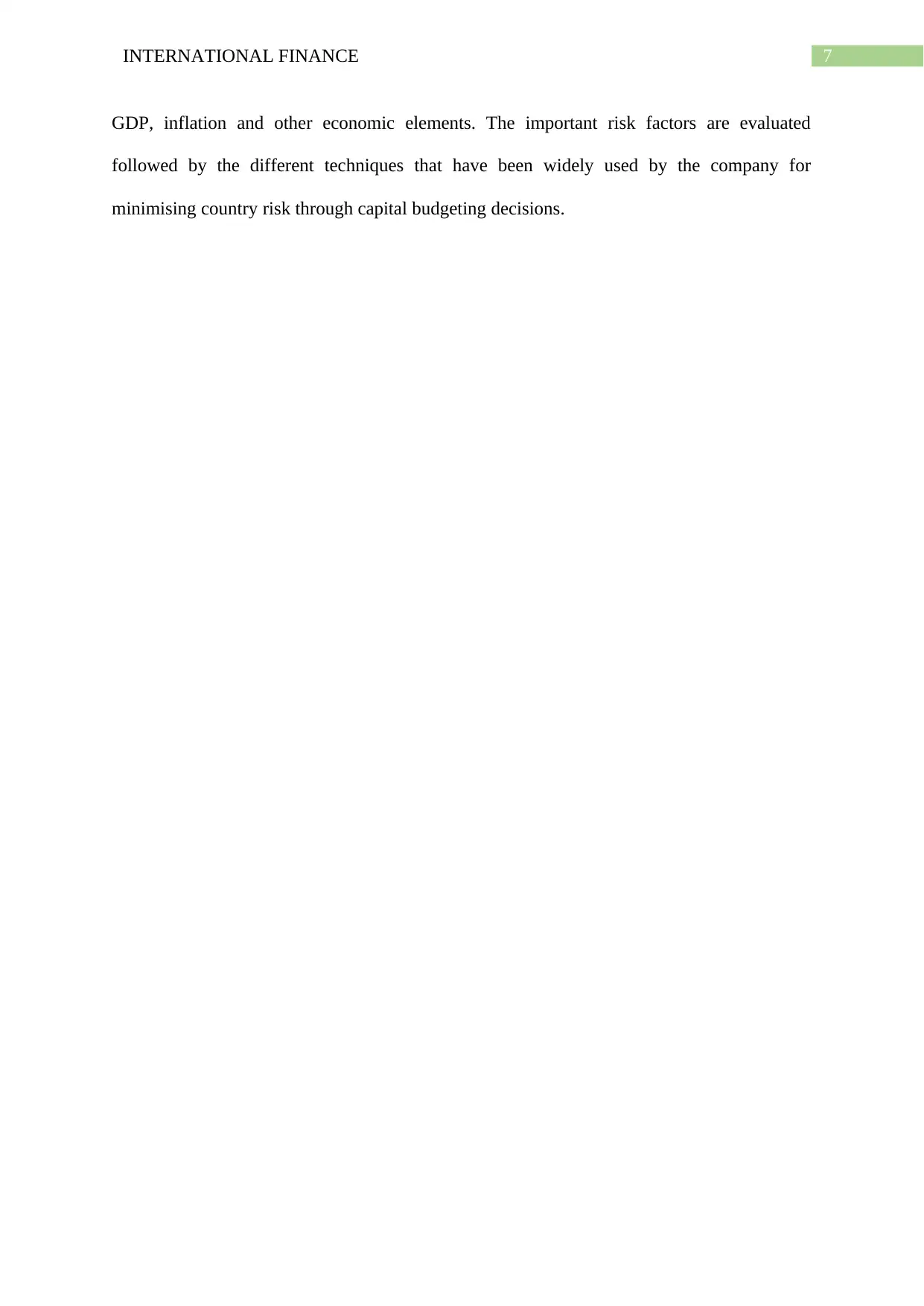
7INTERNATIONAL FINANCE
GDP, inflation and other economic elements. The important risk factors are evaluated
followed by the different techniques that have been widely used by the company for
minimising country risk through capital budgeting decisions.
GDP, inflation and other economic elements. The important risk factors are evaluated
followed by the different techniques that have been widely used by the company for
minimising country risk through capital budgeting decisions.
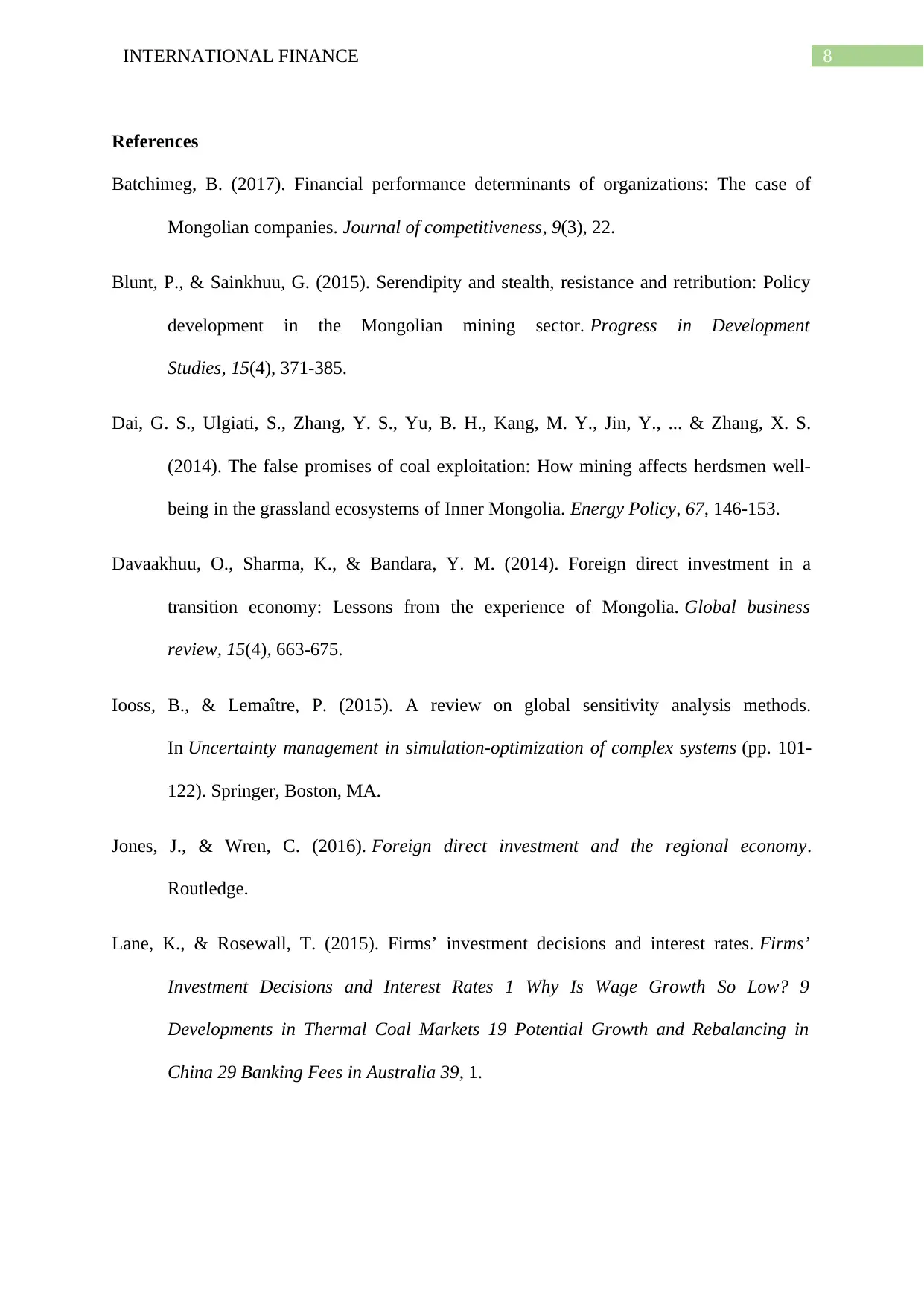
8INTERNATIONAL FINANCE
References
Batchimeg, B. (2017). Financial performance determinants of organizations: The case of
Mongolian companies. Journal of competitiveness, 9(3), 22.
Blunt, P., & Sainkhuu, G. (2015). Serendipity and stealth, resistance and retribution: Policy
development in the Mongolian mining sector. Progress in Development
Studies, 15(4), 371-385.
Dai, G. S., Ulgiati, S., Zhang, Y. S., Yu, B. H., Kang, M. Y., Jin, Y., ... & Zhang, X. S.
(2014). The false promises of coal exploitation: How mining affects herdsmen well-
being in the grassland ecosystems of Inner Mongolia. Energy Policy, 67, 146-153.
Davaakhuu, O., Sharma, K., & Bandara, Y. M. (2014). Foreign direct investment in a
transition economy: Lessons from the experience of Mongolia. Global business
review, 15(4), 663-675.
Iooss, B., & Lemaître, P. (2015). A review on global sensitivity analysis methods.
In Uncertainty management in simulation-optimization of complex systems (pp. 101-
122). Springer, Boston, MA.
Jones, J., & Wren, C. (2016). Foreign direct investment and the regional economy.
Routledge.
Lane, K., & Rosewall, T. (2015). Firms’ investment decisions and interest rates. Firms’
Investment Decisions and Interest Rates 1 Why Is Wage Growth So Low? 9
Developments in Thermal Coal Markets 19 Potential Growth and Rebalancing in
China 29 Banking Fees in Australia 39, 1.
References
Batchimeg, B. (2017). Financial performance determinants of organizations: The case of
Mongolian companies. Journal of competitiveness, 9(3), 22.
Blunt, P., & Sainkhuu, G. (2015). Serendipity and stealth, resistance and retribution: Policy
development in the Mongolian mining sector. Progress in Development
Studies, 15(4), 371-385.
Dai, G. S., Ulgiati, S., Zhang, Y. S., Yu, B. H., Kang, M. Y., Jin, Y., ... & Zhang, X. S.
(2014). The false promises of coal exploitation: How mining affects herdsmen well-
being in the grassland ecosystems of Inner Mongolia. Energy Policy, 67, 146-153.
Davaakhuu, O., Sharma, K., & Bandara, Y. M. (2014). Foreign direct investment in a
transition economy: Lessons from the experience of Mongolia. Global business
review, 15(4), 663-675.
Iooss, B., & Lemaître, P. (2015). A review on global sensitivity analysis methods.
In Uncertainty management in simulation-optimization of complex systems (pp. 101-
122). Springer, Boston, MA.
Jones, J., & Wren, C. (2016). Foreign direct investment and the regional economy.
Routledge.
Lane, K., & Rosewall, T. (2015). Firms’ investment decisions and interest rates. Firms’
Investment Decisions and Interest Rates 1 Why Is Wage Growth So Low? 9
Developments in Thermal Coal Markets 19 Potential Growth and Rebalancing in
China 29 Banking Fees in Australia 39, 1.
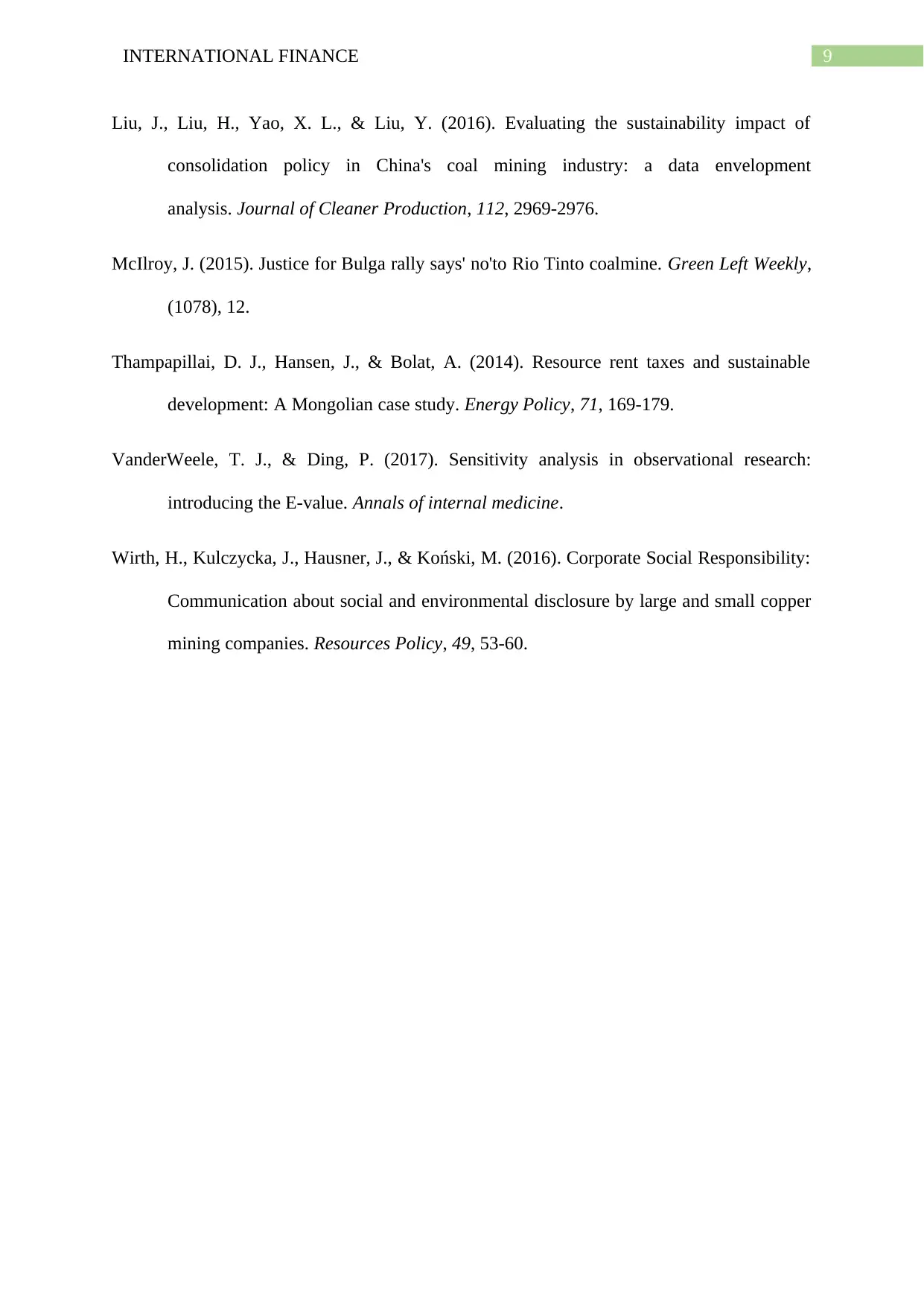
9INTERNATIONAL FINANCE
Liu, J., Liu, H., Yao, X. L., & Liu, Y. (2016). Evaluating the sustainability impact of
consolidation policy in China's coal mining industry: a data envelopment
analysis. Journal of Cleaner Production, 112, 2969-2976.
McIlroy, J. (2015). Justice for Bulga rally says' no'to Rio Tinto coalmine. Green Left Weekly,
(1078), 12.
Thampapillai, D. J., Hansen, J., & Bolat, A. (2014). Resource rent taxes and sustainable
development: A Mongolian case study. Energy Policy, 71, 169-179.
VanderWeele, T. J., & Ding, P. (2017). Sensitivity analysis in observational research:
introducing the E-value. Annals of internal medicine.
Wirth, H., Kulczycka, J., Hausner, J., & Koński, M. (2016). Corporate Social Responsibility:
Communication about social and environmental disclosure by large and small copper
mining companies. Resources Policy, 49, 53-60.
Liu, J., Liu, H., Yao, X. L., & Liu, Y. (2016). Evaluating the sustainability impact of
consolidation policy in China's coal mining industry: a data envelopment
analysis. Journal of Cleaner Production, 112, 2969-2976.
McIlroy, J. (2015). Justice for Bulga rally says' no'to Rio Tinto coalmine. Green Left Weekly,
(1078), 12.
Thampapillai, D. J., Hansen, J., & Bolat, A. (2014). Resource rent taxes and sustainable
development: A Mongolian case study. Energy Policy, 71, 169-179.
VanderWeele, T. J., & Ding, P. (2017). Sensitivity analysis in observational research:
introducing the E-value. Annals of internal medicine.
Wirth, H., Kulczycka, J., Hausner, J., & Koński, M. (2016). Corporate Social Responsibility:
Communication about social and environmental disclosure by large and small copper
mining companies. Resources Policy, 49, 53-60.
1 out of 10
Related Documents
Your All-in-One AI-Powered Toolkit for Academic Success.
+13062052269
info@desklib.com
Available 24*7 on WhatsApp / Email
![[object Object]](/_next/static/media/star-bottom.7253800d.svg)
Unlock your academic potential
© 2024 | Zucol Services PVT LTD | All rights reserved.





